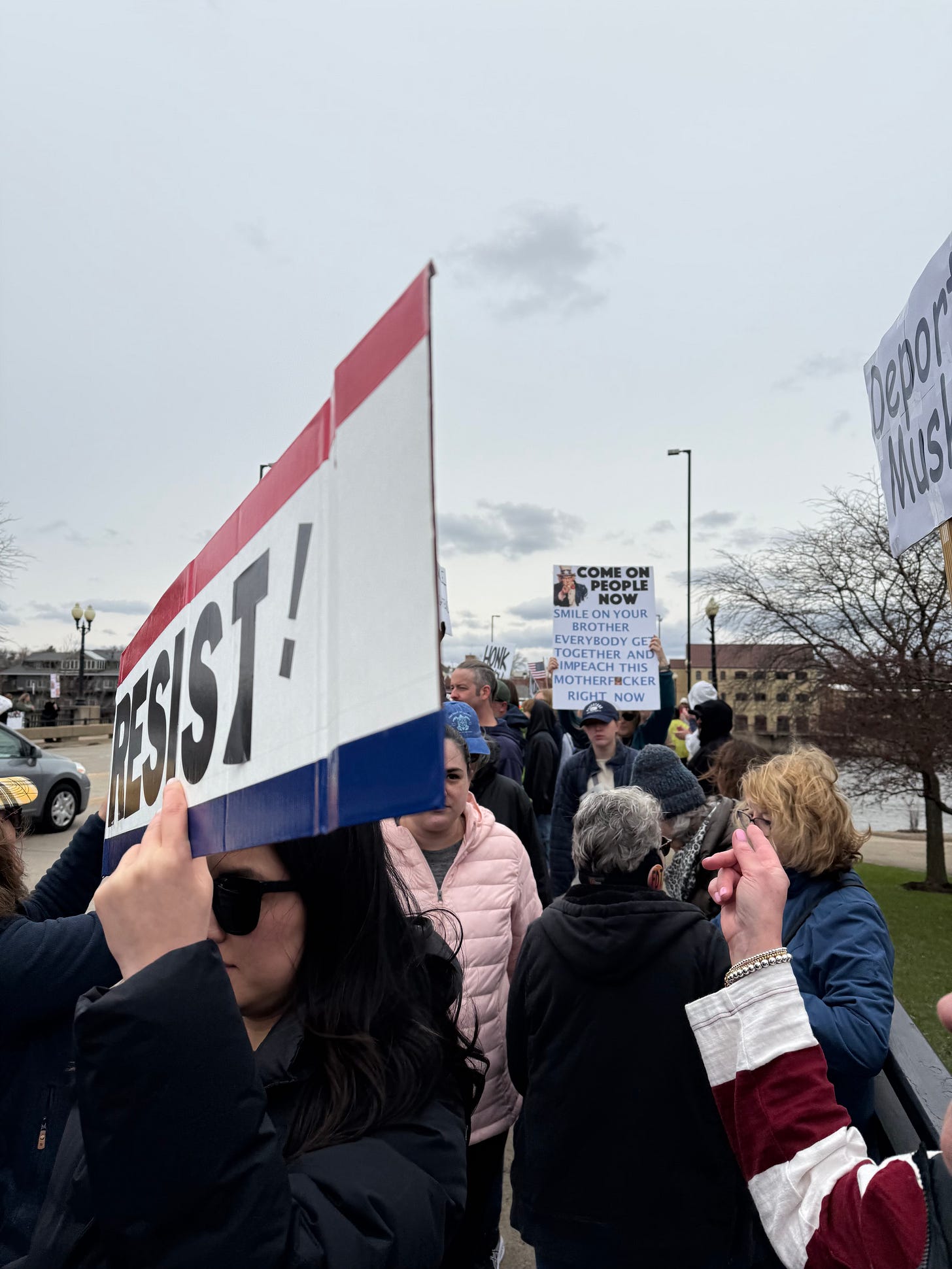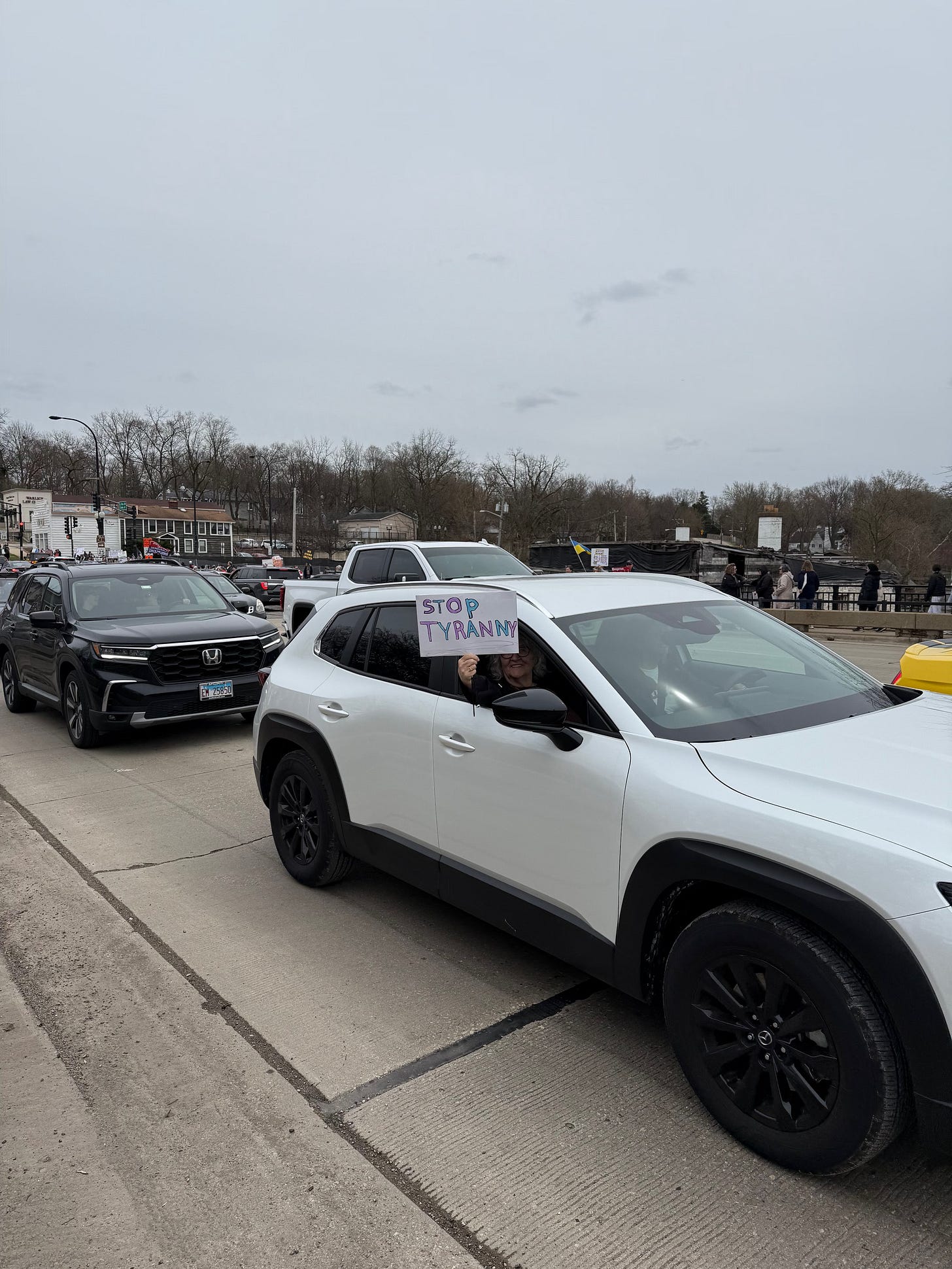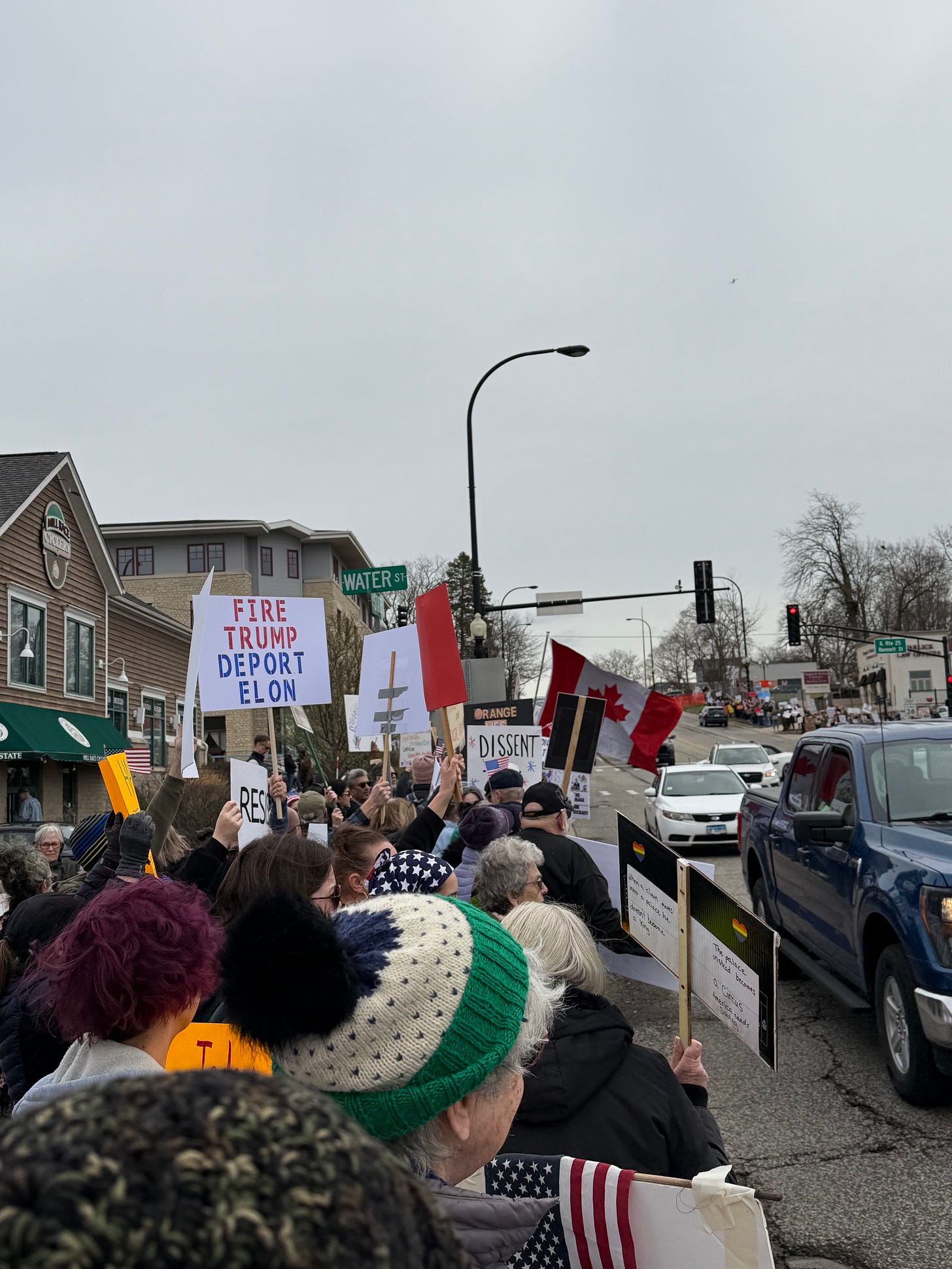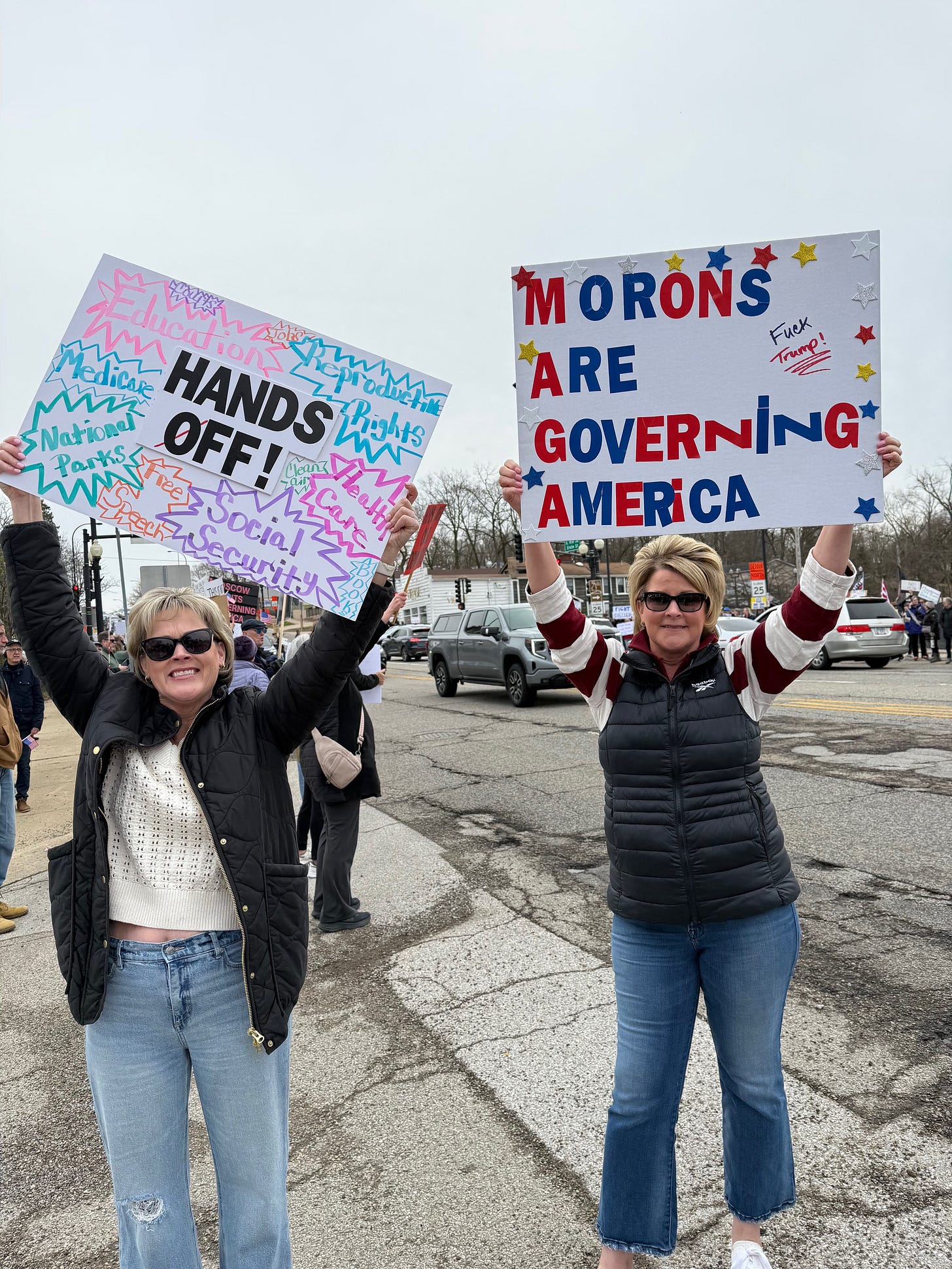Democracy Is Something We Do
A Sisters' Journey to Resistance
Last week in this essay, I explored how strategic silence can become a profound form of resistance in a moment of democratic contraction. I've come to understand that wisdom lies in knowing when stillness must give way to sound and who needs to be making that noise. Last Saturday, across a nation splintering at its seams, millions found their voices. In the middle of the suburban neighborhoods and city centers, on main streets and courthouse steps, many Americans emerged from their homes of worry to stand shoulder to shoulder in what can only be described as a collective act of love – costly, inconvenient, necessary love.
I found myself at one such gathering, in a town of barely 20,000 souls tucked into a deeply conservative corner of our state. A place where political dissent often remains behind closed doors, whispered over dinner tables rather than shouted in streets. Or, implementing the “go along to get along” model of relationship, it’s never discussed. And yet there we were, over 6,000 strong, our presence transforming the familiar geography of this small community into something altogether new: a landscape of resistance.
I attended with a dear friend—one of the few with whom I regularly share my unvarnished fears for our country—and, in a decision that surprised even myself, my two sisters. We share blood and memory and the language that exists only between siblings, though our worldviews have diverged with time and circumstance. In this darkening national moment, when each day seems to bring fresh reason for alarm, I found myself turning toward them with a quiet certainty. It wasn't about politics—though we share the same basic values, our priorities and concerns often differ in their particulars. It was something more essential: a desire to stand in this unsettled moment beside the people who have known me at every stage of my life, who remember me before I had political opinions at all.
The day began with bagels, coffee and the familiar rhythm of sisterly banter. They laughed at my homemade sign—a creation that would struggle to earn a passing grade in any elementary school art class. The laughter bound us together in a way I had almost forgotten, a momentary return to the easy intimacy of our girlhood. We are different women now, with different priorities. One worries deeply about her retirement security, another about rising tariffs and their impact on household budgets. But beneath these differences runs a shared concern for basic human dignity—the right to be oneself without government intrusion.
What struck me, as we walked toward the protest site together, was how our relationship had evolved from the uncomplicated affection of childhood to something more nuanced in adulthood—a love that requires effort, patience, and acceptance of our differences. The same might be said of our relationship with our country. The simple patriotism of youth—the hand over heart, the pledge recited without question—gives way to something more complex as we mature into our full selves. For a decade or more I have been asking myself, “Do I love America?” For years, maybe decades, America’s promise has turned into a fairy tale of some other land, one that existed only in whitewashed history books of my youth.
This week, as I sat looked at the pictures of all these Americans, out on the streets protesting, something rose to mind for me.
Isn't all love costly? Even – perhaps especially – love of country?
We have treated patriotism as though it were a passive inheritance, something bestowed rather than earned. As though loving America required nothing more than a flag on the porch and hand over heart during the anthem. But true love – of person or place or principle – has never been so simple, so uncomplicated by sacrifice. Isn't all love costly? Every love worth having demands something of us.
As we left my youngest sister's home, closest to the protest site, my sister wondered aloud, "Will anyone actually show up?" As we began walking toward the bridge where the protest was planned, we encountered streams of others moving in the same direction—ordinary people carrying handmade signs, their faces animated with purpose rather than the anger so often attributed to protesters.
Nothing prepared me for what awaited us: thousands of bodies stretched along the bridge and down the connecting streets, a physical manifestation of the resistance I had primarily experienced through news reports and social media. Nothing prepared me for the supportive car horns that left my ears ringing, or for the elderly couples waving American flags and their own protest posters from their car windows, cheering for the version of America we all mourned and sought to reclaim.
Yes, there were counter-protesters—mostly young men in pickup trucks swathed with competing flags, their faces contorted with a rage that stood in stark contrast to the atmosphere among the protestors. Yes, the county sheriff's vehicles were visible, officers watching from a distance. But what struck me most profoundly was the absence of anger among the protesters themselves. There was determination, certainly, and righteous indignation, but also a current of unexpected joy—the joy of discovering that you are not alone in your concerns, that the community of resistance is larger and more diverse than you had dared hope.
"It feels good to be on the right side of history," a woman beside me said, her voice steady despite the trembling of her hands. She had lived through the Civil Rights Movement, through Vietnam, through the AIDS crisis and a dozen other American reckonings. Her presence was not a novelty but a continuation.
This is what has been lost in our narratives about protest – the understanding that resistance is not aberration but tradition. That the most American thing one can do is stand on street corners demanding that America live up to its promises.
In the face of what protesters described as a "hostile takeover" of democratic institutions, there was something profound in the sheer ordinariness of those who showed up. These weren't the "radicals" of fevered political imagination. They were the reliable voters, the community volunteers, the school board meeting attendees – the people that make up the framework upon which functional democracy has rested.
I watched an elderly couple in folding chairs they'd brought from home, cowbells in their laps that they rang whenever a chant rose from the crowd. I saw a man who must have been in his eighties holding a sign that read simply: "I've seen this before." The weight of that statement, the historical memory it contained, hung in the air around him like something palpable.
What we witnessed last week across America wasn't merely political demonstration – it was a nationwide act of reclamation. A collective declaration that America belongs not to those who would dismantle its protections for the vulnerable, but to all who labor to uphold them. To love something, truly love it, is to fight for its soul when that soul is threatened.
There is a particular kind of alienation that comes from watching one's country veer toward authoritarianism from the isolation of one's living room. The antidote, I discovered, lies in the ancient human medicine of gathering. Of standing physically among others who share your grief and your resolve. No tweet or online petition can replicate the power of bodies assembled in public space, the electricity that passes between strangers united in purpose.
"For everyone out there with a sign," someone told me, "there were probably half a dozen folks who wanted to be there." I believe this. The organizers expected hundreds of thousands. Instead, millions flooded the streets. And yet, I believe there exists in America today an even vaster reservoir of people who recognize the peril of this moment but haven't yet found their way to the streets. What happens when they do? What happens when the dam breaks on that reservoir of latent resistance? You can stop asking where the mass opposition is. It's everywhere.
This is what I meant in "The Power of Stillness" when I wrote about "moments of contraction" that can "give birth to something that is even larger and bigger and better." The transformation that occurs when private anguish transforms into public action, when the temperature of civic engagement rises from simmer to boil—this is the birth process Senator Warnock described. It is painful, yes. It is uncertain. But it carries the possibility of renewal.
I went to the protest last Saturday carrying the weight of my own despair. I returned home carrying something else – not the fragile optimism of wishful thinking but hope with muscle and bone. Hope that knows its own strength because it has been tested in a shared purpose. A mentor of mine used to say that you pray to fortify the fighter, not to influence the direction of the fight. Yesterday I understood this wisdom anew: so much of what we do in this life is to fortify ourselves to keep going, uncertain of the outcomes of our actions. Yet we keep on.
I invited my sisters and my friend to the protest not just to add three more bodies to the count, but to help them understand something I've come to know: that protest serves a dual purpose. Yes, it communicates dissent to those in power. But equally important, perhaps more so, it nourishes the protester. It transforms isolation into community. It converts abstract concerns into shared purpose. When we began our walk toward the bridge, my sisters were skeptical that anyone would show up. When we departed hours later, their faces shone with the energy that comes from discovering your people—those willing to stand beside you in defense of shared values, even when doing so carries risk.
My sisters
The true gift of these "Hands Off" demonstrations lay in their physicality – the irreplaceable power of standing shoulder to shoulder with strangers who share your fears and your resolve. No screen can replicate this communion. No social media declaration can nourish the spirit like the press of bodies across the bridge of a small town in Illinos, the call and response of voices united in purpose. We will need this nourishment. The path ahead in American stretches long and uneven before us.
I had fallen in love with America again – not with the America that exists in presidential decrees or policy directives, but with the America that assembles in public spaces when liberty is threatened. Not with the America being dismantled piece by constitutional piece, but with the America written on the faces of ordinary citizens who refuse to witness that dismantling in silence.
Love of country, like all meaningful love, asks something of us. It demands witnessing, presence, courage in the face of fear. It requires that we stand up when standing up is hard. That we speak when silence would be easier.
Some protest advice circulated: "Don't post any photos!" But this caution applies differently across demographics. For BIPOC individuals, for immigrants, for the vulnerable, digital anonymity remains crucial. But for those with privilege – particularly white Americans – visibility matters. We need the demographics that voted for this administration to be visibly present, both physically and digitally, in opposition. Their presence encourages others like them to follow.
People poured out to protest not only what has already happened but what they fear will happen next. They protested to fortify themselves and each other for the long struggle ahead. In the words of Senator Warnock, these moments of democratic contraction can "give birth to something that is even larger and bigger and better" – but only if we have the courage to stand in the breach.
Last Saturday, across a nation that contains both our deepest wounds and our most enduring wonders, millions chose the harder path of love. They chose to bear witness. To be counted. To assert through their presence that the story of America is still being written, and that they intend to hold the pen.
I was one among them, rediscovering across a small-town bridge packed with people what I had nearly forgotten: that democracy is not something we have, but something we do. And last weekend, America did democracy in the streets, with signs raised high and voices raised higher, in a nationwide chorus that proclaimed: We are still here. We are still fighting. We still believe.
And in that belief – costly and inconvenient as it may be – lies the seed of everything worth saving. Let's struggle well, America
.





